Best Instant Cameras
We tested more than a dozen instant cameras. Here are the best.
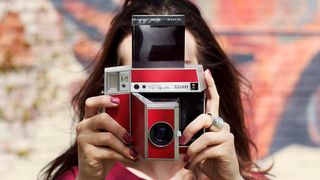
Even as the capabilities of sleek, thin, smartphone cameras expand, there's increasing nostalgia for a past era when the chunky Polaroid instant-film camera was the life of the party.
After testing more than a dozen instant cameras, our favorite is the Lomography Lomo'Instant Automat, which has a cool look, comes with add-on lenses, and most importantly, takes great pictures. However, there are others on this list that have other features, such as Polaroid Snap Touch, which can print photos from your smartphone, too.
Here are the best instant cameras.

Lomo'Instant Automat
Our expert review:
Specifications
Reasons to buy
With its 38-millimeter wide-angle, multicoated f/4.5 glass lens, the Lomo'Instant Automat gives you sharper images, better low-light performance and a wider field of view than its competitors.
Auto mode lets the camera adjust aperture (f/4.5- f/22), shutter speed and flash output. The Automat has a remote built into its lens cap, so you can more easily take group shots or exposures up to 30 seconds. (It has a tripod mount, too.) Zone focusing helps measure the proper distance for the best shot, and we liked its optical viewfinder. The camera and remote use two different batteries (sold separately).
At whatever distance I tried, pictures from the Lomo Instant Glass Magellan were incredibly sharp. Its size made it convenient to carry around, and it performs well in low-light; it did not even require a lighten mode to take some night shots in the yellow streetlamp of a park. The only issue I had was with the close-up lens, which was a bit stubborn when I tried to remove it.
Lomography sells several versions of the Lomo’Instant Automat, some of which include add-on lenses, such as a "Splitzer" gizmo that divides the frame into different sectors, and a lens for shooting extreme close-ups, up to a foot from your subject.
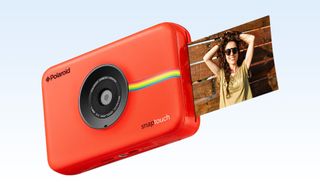
Polaroid Snap Touch
Our expert review:
Specifications
Reasons to buy
Smartphone users will be immediately comfortable with the Polaroid Snap Touch's 3.5-inch LCD touch screen. It features three color modes — black and white, color, and vintage sepia and also records 1080p and 720p video, which you can store on a microSD card.
The camera can pair with your smartphone via Bluetooth and has an app (iOS and Android) that offers additional photographic options, like text, borders, emojis and stickers. Unlike other instant cameras, which will automatically pump out a print even if it's snapped by accident, the Snap Touch lets you preview, choose, print or discard any shot so you waste less precious paper.
Images shot outdoors during the day displayed true colors and decent skin tones with plenty of detail, though some indoor shots came out a bit dark and muddy, despite the flash. Generally, close-ups looked better than long-distance shots.
The ability to dress up images with emojis and stickers and improve them with filters or digitally enlarge them is a bonus. You can also use the app to print images shot from your smartphone when connected to the camera via Bluetooth. Since the Zink paper is not film, if the paper jams, you can easily open the back of the camera to tap the paper into place and resume printing without causing any damage to the picture.
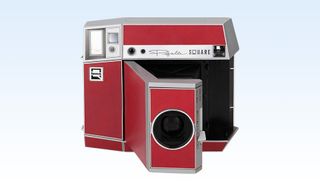
Lomo'Instant Square
Our expert review:
Specifications
Reasons to buy
The Lomo'Instant Square features a 95-mm (45-mm equivalent) glass lens that encourages creativity. Its old-school bellows design will be unfamiliar to most, but it folds flat to about one-third of its operational size, making it more convenient to tote.
A variety of manual controls include the ability to take multiple exposures and a long exposure mode that keeps the shutter open for up to 30 seconds. The camera has a self-timer, as well as a remote control that detaches from the camera (and requires its own battery).
Also included are four gel filters to give different color casts to your images, cards that show what images will look like at various settings, and clips, stands, glue dots and magnet stickers to display your photos.
Portraits have an evocative quality — clear, with soft flesh tones — while landscapes provided pinpoint detail and pleasing colors, similar those from the Lomo'Instant Automat. Night shots, with and without flash, and augmented with available streetlights, can make a storyteller out of any casual shooter.
The shutter — a square tab on the front — is extremely sensitive, so you have to watch how you hold the camera so as not to fire a shot accidentally. The shots from the glass lens are refreshingly sharp and clear, though focusing through the lens takes some getting used to. The camera has a bit of a parallax effect, so that what you see through the lens is an approximation of what you will actually capture.

Kodak Smile
Our expert review:
Specifications
Reasons to buy
This simple and inexpensive digital camera has a number of features we really like: A slide-open mechanism protects the lens and keeps the camera from turning on accidentally; buttons on the back make it easy to navigate menus, and you can review photos on the Smile's small LCD display before opting to print them out.
However, the quality of the prints from the Kodak Smile was a step below other Zink cameras, such as the Canon Ivy Cliq+. Whites turned a bit pinkish, and other colors were muted. Also, the digital images stored by the Smile are on the small side.
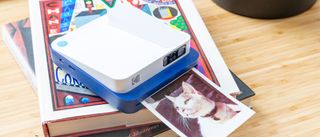
Kodak Smile Classic
Our expert review:
Specifications
Reasons to buy
The Kodak Smile Classic's design riffs on the iconic Polaroid instant camera, but in a slightly more compact design. The thing we liked the most about the Smile Classic is its massive prints, which measure 4.25 x 3.5 inches—very satisfying. While the camera prints out every photo you take with it, you can also use it to print photos from your smartphone, and add filters and stickers in the process. Of course, with larger prints comes more expensive paper, but it's a good tradeoff.
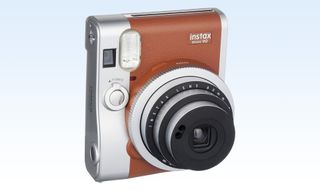
Fujifilm Instax Mini 90
Our expert review:
Specifications
Reasons to buy
With its classic retro style and 60-mm, f/12.7 lens, the Fujifilm Instax Mini 90 is an appealing choice for hobbyists seeking a change of pace. An easy-to-read monochrome LCD readout keeps track of your settings and film counter, while the Mode button lets you cycle through different scenarios (such as sports or landscape).
The Mini 90 has an electronic macro setting for more creative shots, as well as two shutter buttons to make it easier to snap portraits or landscape photos. Unlike with some other instant cams, you can turn the Mini 90's flash on or off.
In Macro mode, the viewfinder automatically adjusts to show a better preview of your shot. The lighten/darken button, which operates like exposure compensation, made it easy to expose two shots on the same sheet of film.
My favorite daytime and macro shots — which were sharp and had deep, vivid colors — were taken in late-afternoon sunlight under bright conditions. Night shots came out well, both indoors and out. The Party mode worked well without the flash, especially when augmented by a fairly strong outside light source; with the flash, subjects were well lit.
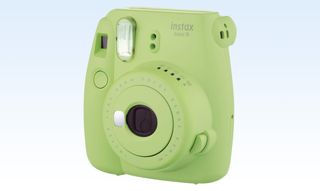
Fujifilm Instax Mini 9
Our expert review:
Specifications
Reasons to buy
The Fujifilm Instax Mini 9 comes in a variety of bright colors: Cobalt Blue, Flamingo Pink, Ice Blue, Smoky White and Lime Green. Combined with a smooth, curved design and a dotted hand strap, it looks a bit toy-like. Still, it is exceptionally easy to use.
An included close-up lens accessory snaps on with an audible click. From there, an LED lamp on the side of the lens guides you on where to adjust the exposure. A high-key option lightens images and assists in exposing darker environments. The camera automatically lights up on the mode that's best for your shot, but you have to rotate the lens to the right place before taking the shot and be sure to keep the proper distance from your subject.
The default 60-mm f/12.7 lens has a minimum focusing distance of about 2 feet, while the close-up lens lets you focus from approximately 1 foot away. Because of the camera's automated functions, there are limited customizable settings. The close-up lens made focusing tricky; you have to center the focus circle just slightly to the upper right of the subject.
The camera's shutter speed is fixed at 1/60 of a second, and the flash fires no matter what. In bright light, if I moved the camera or my feet ever so slightly, the camera often chose a different exposure setting. With distance and lighting problems solved, the Instax Mini 9 shot clear images with pleasing, fairly accurate color, with especially good results in broad daylight. Unlike with some cameras, there is no tripod mount or bulb setting, so if you shoot in low light, you must rely on the camera's auto flash.
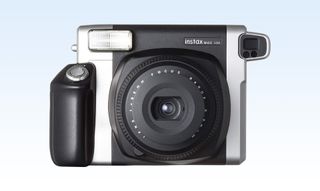
Fujifilm Instax Wide 300
Our expert review:
Specifications
Reasons to buy
The Fujifilm Instax Wide 300 is a bulky beast. It has a 114-mm, f/14 lens and uses only Instax Wide film for a picture that's ideal for capturing landscapes or groups of people. While the camera has a digital readout, it has fewer controls than the Mini 90.
It includes a snap-on close-up lens which is easy to lose. The camera's auto flash optimizes the lighting according to distance, and you can choose the fill-in flash with a flash-on LCD button.
The best thing about the Instax Wide 300 is the size of its pictures: They are big. And despite the camera's weight, its handgrip makes it comfortable to hold. Daylight images were bright with accurate color, though the focus was a bit soft. The default focus distance is almost 9 feet. Unlike some Instax cameras, the Wide 300 lets you twist the lens one way to focus from 3 to 9 feet and the other way to capture images from 9 feet and up.
The Wide 300's powerful flash is a real help when shooting photos at night, especially when the subject is close, and a handy tripod socket lets you anchor the camera for a steadier shot. A combination of the infinity setting, the auto flash and a light source produced bright images at night within the shooting range. However, the Wide 300's flash fires automatically in some situations, which can overexpose some photos.
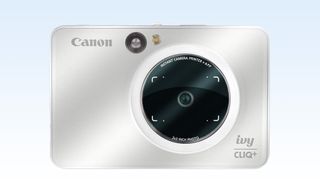
Canon Ivy Cliq+
Our expert review:
Specifications
Reasons to buy
The Canon Ivy Cliq+ not only takes photos and prints them on Zink paper, but it can also connect to your smartphone and print photos from your mobile device, too. We liked the Cliq+'s clean, simple design and thin size, which made it pretty easy to fit in a pocket. Surrounding the lens is a circular mirror, for all those selfies you plan to take.
We liked the quality of the images printed from the Cliq+, but didn't like the fact that we couldn't review the photos we took with the camera, nor select those we wanted to print.
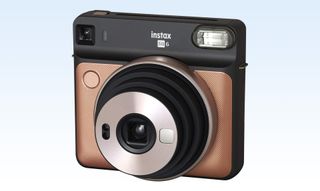
Fujifilm Instax Square SQ6
Our expert review:
Specifications
Reasons to buy
Fujifilm's Instax Square SQ6 is the company's first fully analog square cam with a 65.75-mm lens. The camera features three focusing ranges: macro (1 to 1.6 feet), auto (1.6 to 6.6 feet) and landscape (6 feet and up).
Auto exposure control calculates the brightness to adjust the shutter speed and flash, but the SQ6 gives you plenty of flexibility, including flash suppression and various shooting modes. Whichever one you pick, the camera will make its own internal adjustments. The package also includes three color filters — orange, purple and green — that can be fitted over the flash to add a color cast to your photo.
The camera also includes a self-timer and a tripod mount. You get some control over your images — including flash and double exposure — but this camera gives you much larger square prints.
With the Automatic setting, the SQ6 captured accurate color and skin tones, though the image was not super sharp. As I got closer to the subject, the skin tones were truer, even with the flash on.
I managed to blow a shot by accidentally hitting the shutter button and ruined another shot when changing double exposure settings.
Sign up to get the BEST of Tom’s Guide direct to your inbox.
Upgrade your life with a daily dose of the biggest tech news, lifestyle hacks and our curated analysis. Be the first to know about cutting-edge gadgets and the hottest deals.

Michael A. Prospero is the U.S. Editor-in-Chief for Tom’s Guide. He oversees all evergreen content and oversees the Homes, Smart Home, and Fitness/Wearables categories for the site. In his spare time, he also tests out the latest drones, electric scooters, and smart home gadgets, such as video doorbells. Before his tenure at Tom's Guide, he was the Reviews Editor for Laptop Magazine, a reporter at Fast Company, the Times of Trenton, and, many eons back, an intern at George magazine. He received his undergraduate degree from Boston College, where he worked on the campus newspaper The Heights, and then attended the Columbia University school of Journalism. When he’s not testing out the latest running watch, electric scooter, or skiing or training for a marathon, he’s probably using the latest sous vide machine, smoker, or pizza oven, to the delight — or chagrin — of his family.
